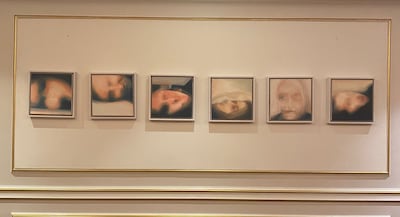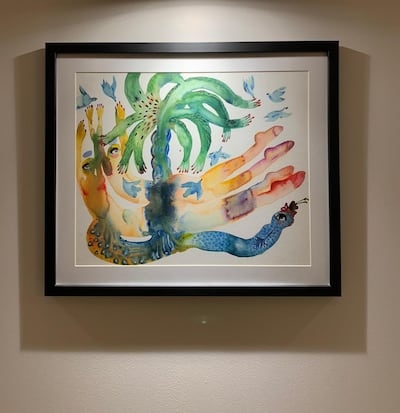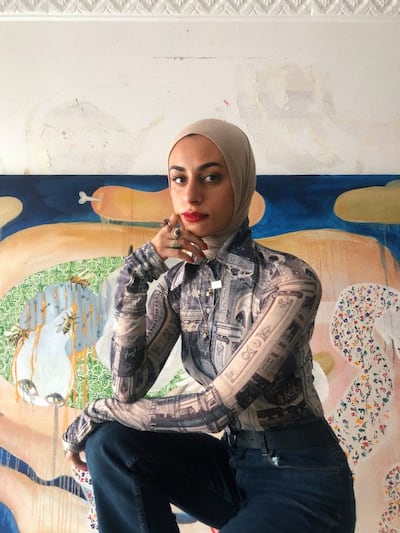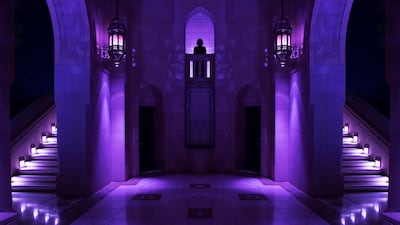Art isn’t immune to gender inequality. Various surveys and research on representation and sales in the market have proven this time and again, including a 2019 study by In Other Words art agency and Artnet News revealing that works by women accounted for only 2 per cent of worldwide auction sales over nearly a 10-year period.
Gallerist Oceane Sailly, who is also part of an international research group that studies inequity in the art world, is aware of this. “In the US, Germany, France and the UK, when we look at the main art fairs and museum collections, there is still a huge discrepancy in terms of representation,” she says.
Sailly also says that the pandemic has made matters worse, with many gallerists choosing to showcase more male artists to secure more income. “They’re considered safer and sell better,” she explains.
Still, in early 2021, Sailly went against the current and established Hunna, a contemporary art gallery representing female artists in the Gulf. The word is the Arabic feminine form of “they/them” and can be loosely interpreted as “the women”.
Last Thursday, Hunna opened its first physical exhibition since running virtually for the past year. Titled Pathways, the show features the works of four artists: Kuwaiti artist Alymamah Rashed; Emirati artist Alia Zaal; Eman Ali, who lives between Oman and London; and Syrian artist Talin Hazbar, who lives in the UAE.
The exhibition is on view at various sites in Raffles The Palm Dubai and runs until March 23.
The artists are among the nine names represented by Hunna. Others include Qamar Abdulmalik, Moza Almatrooshi, Aysha Almoayyed, Aidha Badr and Razan Al Sarraf. A 10th artist will be announced in February.
Sailly, who is from France, has worked in the region since 2015, primarily as a researcher on French cultural diplomacy in the Gulf. She lived in Kuwait for two years before moving to Abu Dhabi recently, and she is currently completing her PhD at the Sorbonne University in Paris.
To set up Hunna, she left her role at another gallery that she had established with her sister in France. At the time, she was living in Kuwait and was exposed to the art scene there.
Though she knew she wanted to highlight Gulf artists, she didn’t expect to focus solely on women. It was when she started compiling a list of whom she wanted to represent that she noticed a pattern.
“Some of the artists were already my close friends. I didn’t have some underlying idea to necessarily have all women artists, but once I started to do it, these were the names that came up,” she says.
The decision has brought a different dynamic to the way Hunna works. “The fact that they’re all female, we have created a safe space between us,” she says. “When we’re together, we can speak about anything we want.”
When it comes to women’s rights and roles in the region, the Gulf is still a way off compared to the rest of the Middle East and North Africa in areas such as workforce participation, for example.
For Sailly, the artists at Hunna are “bringing new perspectives in a world that’s shifting”. She says, “Through their artistic practices, they are addressing cultural, historical and social topics that have been long left out of the dominant narratives on the region.”
Indeed a number of the gallery’s artists address societal issues through multiple lenses, including gender. Zaal, for example, whose inventive portraits and self-portraits in Pathways are abstract representation of the individual. She does this by the blurring of features, as in a series of works where the artist paints a portrait based on a photograph of herself, then photographs the canvas, layering elements of both mediums.
In another work, installed in the Raffles The Palm Dubai’s library, Zaal has created a pixelated self-portrait accompanied by blocks or 3D pixels in various flesh tones, with two white and black cubes acting as her eyes. This erasure of self is not only an exploration in material, but also a deeper look at identity in the context of the emirates.
“As much as we care about who we are, our own names, we are also so homogenous in our dress and our beliefs. I wanted to show that by removing the subject from this portrait,” she says.
Meanwhile, Ali’s series Corridors of Power also examine the individual’s place within a society swiftly changing. Photographed inside the Sultan Qaboos Grand Mosque in Oman, the artist embeds herself quietly, sometimes almost invisibly, in the grand architectural scenes.
Her choice to tinge the images in purple highlights the “artificiality of the palace”, she says. “It’s made in this neo-Islamic architectural style that has no real identity. It could be anywhere.” It’s true that Ali has produced a non-place, a neon netherworld where individuality is overpowered by the state.
In Rashed’s body of work My Palm Fronds Breathe For You, hybrid creatures of human and palm tree contort themselves in strange configurations. The artist’s distinct style visualizes a personal, spiritual reckoning as the artist rediscovers aspects of her religion.
Both Ali’s and Rashed’s works are displayed in the hallways of the hotel lobby.
Finally, Hazbar’s Stones in Silence features two installations resulting from her years-long research on landscapes and the natural environment of the UAE. Using stones as her material, the artist has cleaved, carved and transformed them into art objects. Through her work, Hazbar reflects on local ecologies and the histories and myths tied to them.
Despite the works in Pathways, the exhibition struggles to shine within its setting at Raffles The Palm Dubai. Not only were a number of works hidden away, Hazbar’s, for example, others couldn’t stand out against the hotel’s opulent interiors.
Perhaps these are only growing pains. The gallery plans to exhibit two more shows this year and eventually establish a permanent space towards the end of 2022.
Its roster of artists remains Hunna's best quality, and not simply for their gender, but also the ideas the artists continually confront in their work.
This is what Sailly values the most. “Everyone is strongly opinionated, but also very supportive. It’s become a space I really want to protect,” she says.
Pathways is on view at Raffles The Palm Dubai until March 23. More information is available at hunna.art
French business
France has organised a delegation of leading businesses to travel to Syria. The group was led by French shipping giant CMA CGM, which struck a 30-year contract in May with the Syrian government to develop and run Latakia port. Also present were water and waste management company Suez, defence multinational Thales, and Ellipse Group, which is currently looking into rehabilitating Syrian hospitals.
The biog
Hobby: Playing piano and drawing patterns
Best book: Awaken the Giant Within by Tony Robbins
Food of choice: Sushi
Favourite colour: Orange
COMPANY%20PROFILE
%3Cp%3E%3Cstrong%3EName%3A%20%3C%2Fstrong%3ESmartCrowd%0D%3Cbr%3E%3Cstrong%3EStarted%3A%20%3C%2Fstrong%3E2018%0D%3Cbr%3E%3Cstrong%3EFounder%3A%20%3C%2Fstrong%3ESiddiq%20Farid%20and%20Musfique%20Ahmed%0D%3Cbr%3E%3Cstrong%3EBased%3A%20%3C%2Fstrong%3EDubai%0D%3Cbr%3E%3Cstrong%3ESector%3A%20%3C%2Fstrong%3EFinTech%20%2F%20PropTech%0D%3Cbr%3E%3Cstrong%3EInitial%20investment%3A%20%3C%2Fstrong%3E%24650%2C000%0D%3Cbr%3E%3Cstrong%3ECurrent%20number%20of%20staff%3A%3C%2Fstrong%3E%2035%0D%3Cbr%3E%3Cstrong%3EInvestment%20stage%3A%20%3C%2Fstrong%3ESeries%20A%0D%3Cbr%3E%3Cstrong%3EInvestors%3A%20%3C%2Fstrong%3EVarious%20institutional%20investors%20and%20notable%20angel%20investors%20(500%20MENA%2C%20Shurooq%2C%20Mada%2C%20Seedstar%2C%20Tricap)%3C%2Fp%3E%0A
In numbers: China in Dubai
The number of Chinese people living in Dubai: An estimated 200,000
Number of Chinese people in International City: Almost 50,000
Daily visitors to Dragon Mart in 2018/19: 120,000
Daily visitors to Dragon Mart in 2010: 20,000
Percentage increase in visitors in eight years: 500 per cent
T20 World Cup Qualifier, Muscat
UAE FIXTURES
Friday February 18: v Ireland
Saturday February 19: v Germany
Monday February 21: v Philippines
Tuesday February 22: semi-finals
Thursday February 24: final
Our legal columnist
Name: Yousef Al Bahar
Advocate at Al Bahar & Associate Advocates and Legal Consultants, established in 1994
Education: Mr Al Bahar was born in 1979 and graduated in 2008 from the Judicial Institute. He took after his father, who was one of the first Emirati lawyers
How to wear a kandura
Dos
- Wear the right fabric for the right season and occasion
- Always ask for the dress code if you don’t know
- Wear a white kandura, white ghutra / shemagh (headwear) and black shoes for work
- Wear 100 per cent cotton under the kandura as most fabrics are polyester
Don’ts
- Wear hamdania for work, always wear a ghutra and agal
- Buy a kandura only based on how it feels; ask questions about the fabric and understand what you are buying
More from Rashmee Roshan Lall
PROFILE OF HALAN
Started: November 2017
Founders: Mounir Nakhla, Ahmed Mohsen and Mohamed Aboulnaga
Based: Cairo, Egypt
Sector: transport and logistics
Size: 150 employees
Investment: approximately $8 million
Investors include: Singapore’s Battery Road Digital Holdings, Egypt’s Algebra Ventures, Uber co-founder and former CTO Oscar Salazar
Milestones on the road to union
1970
October 26: Bahrain withdraws from a proposal to create a federation of nine with the seven Trucial States and Qatar.
December: Ahmed Al Suwaidi visits New York to discuss potential UN membership.
1971
March 1: Alex Douglas Hume, Conservative foreign secretary confirms that Britain will leave the Gulf and “strongly supports” the creation of a Union of Arab Emirates.
July 12: Historic meeting at which Sheikh Zayed and Sheikh Rashid make a binding agreement to create what will become the UAE.
July 18: It is announced that the UAE will be formed from six emirates, with a proposed constitution signed. RAK is not yet part of the agreement.
August 6: The fifth anniversary of Sheikh Zayed becoming Ruler of Abu Dhabi, with official celebrations deferred until later in the year.
August 15: Bahrain becomes independent.
September 3: Qatar becomes independent.
November 23-25: Meeting with Sheikh Zayed and Sheikh Rashid and senior British officials to fix December 2 as date of creation of the UAE.
November 29: At 5.30pm Iranian forces seize the Greater and Lesser Tunbs by force.
November 30: Despite a power sharing agreement, Tehran takes full control of Abu Musa.
November 31: UK officials visit all six participating Emirates to formally end the Trucial States treaties
December 2: 11am, Dubai. New Supreme Council formally elects Sheikh Zayed as President. Treaty of Friendship signed with the UK. 11.30am. Flag raising ceremony at Union House and Al Manhal Palace in Abu Dhabi witnessed by Sheikh Khalifa, then Crown Prince of Abu Dhabi.
December 6: Arab League formally admits the UAE. The first British Ambassador presents his credentials to Sheikh Zayed.
December 9: UAE joins the United Nations.
Zayed Sustainability Prize
ESSENTIALS
The flights
Emirates, Etihad and Swiss fly direct from the UAE to Zurich from Dh2,855 return, including taxes.
The chalet
Chalet N is currently open in winter only, between now and April 21. During the ski season, starting on December 11, a week’s rental costs from €210,000 (Dh898,431) per week for the whole property, which has 22 beds in total, across six suites, three double rooms and a children’s suite. The price includes all scheduled meals, a week’s ski pass, Wi-Fi, parking, transfers between Munich, Innsbruck or Zurich airports and one 50-minute massage per person. Private ski lessons cost from €360 (Dh1,541) per day. Halal food is available on request.
GOODBYE%20JULIA
%3Cp%3E%3Cstrong%3EDirector%3A%20%3C%2Fstrong%3EMohamed%20Kordofani%3C%2Fp%3E%0A%3Cp%3E%3Cstrong%3EStarring%3A%20%3C%2Fstrong%3ESiran%20Riak%2C%20Eiman%20Yousif%2C%20Nazar%20Goma%3C%2Fp%3E%0A%3Cp%3E%3Cstrong%3ERating%3A%3C%2Fstrong%3E%205%2F5%3C%2Fp%3E%0A
Jetour T1 specs
Engine: 2-litre turbocharged
Power: 254hp
Torque: 390Nm
Price: From Dh126,000
Available: Now
War 2
Director: Ayan Mukerji
Stars: Hrithik Roshan, NTR, Kiara Advani, Ashutosh Rana
Rating: 2/5
How the UAE gratuity payment is calculated now
Employees leaving an organisation are entitled to an end-of-service gratuity after completing at least one year of service.
The tenure is calculated on the number of days worked and does not include lengthy leave periods, such as a sabbatical. If you have worked for a company between one and five years, you are paid 21 days of pay based on your final basic salary. After five years, however, you are entitled to 30 days of pay. The total lump sum you receive is based on the duration of your employment.
1. For those who have worked between one and five years, on a basic salary of Dh10,000 (calculation based on 30 days):
a. Dh10,000 ÷ 30 = Dh333.33. Your daily wage is Dh333.33
b. Dh333.33 x 21 = Dh7,000. So 21 days salary equates to Dh7,000 in gratuity entitlement for each year of service. Multiply this figure for every year of service up to five years.
2. For those who have worked more than five years
c. 333.33 x 30 = Dh10,000. So 30 days’ salary is Dh10,000 in gratuity entitlement for each year of service.
Note: The maximum figure cannot exceed two years total salary figure.
Lexus LX700h specs
Engine: 3.4-litre twin-turbo V6 plus supplementary electric motor
Power: 464hp at 5,200rpm
Torque: 790Nm from 2,000-3,600rpm
Transmission: 10-speed auto
Fuel consumption: 11.7L/100km
On sale: Now
Price: From Dh590,000
RESULTS
6pm: Al Maktoum Challenge Round-2 – Group 1 (PA) $55,000 (Dirt) 1,900m
Winner: Rajeh, Antonio Fresu (jockey), Musabah Al Muhairi (trainer)
6.35pm: Oud Metha Stakes – Rated Conditions (TB) $60,000 (D) 1,200m
Winner: Get Back Goldie, William Buick, Doug O’Neill
7.10pm: Jumeirah Classic – Listed (TB) $150,000 (Turf) 1,600m
Winner: Sovereign Prince, James Doyle, Charlie Appleby
7.45pm: Firebreak Stakes – Group 3 (TB) $150,000 (D) 1,600m
Winner: Hypothetical, Mickael Barzalona, Salem bin Ghadayer
8.20pm: Al Maktoum Challenge Round-2 – Group 2 (TB) $350,000 (D) 1,900m
Winner: Hot Rod Charlie, William Buick, Doug O’Neill
8.55pm: Al Bastakiya Trial – Conditions (TB) $60,000 (D) 1,900m
Winner: Withering, Adrie de Vries, Fawzi Nass
9.30pm: Balanchine – Group 2 (TB) $180,000 (T) 1,800m
Winner: Creative Flair, William Buick, Charlie Appleby
Read more about the coronavirus
Results
Men's finals
45kg:Duc Le Hoang (VIE) beat Zolfi Amirhossein (IRI) points 29-28. 48kg: Naruephon Chittra (THA) beat Joseph Vanlalhruaia (IND) TKO round 2.
51kg: Sakchai Chamchit (THA) beat Salam Al Suwaid (IRQ) TKO round 1. 54kg: Veerasak Senanue (THA) beat Huynh Hoang Phi (VIE) 30-25.
57kg: Almaz Sarsembekov (KAZ) beat Tak Chuen Suen (MAC) RSC round 3. 60kg: Yerkanat Ospan (KAZ) beat Ibrahim Bilal (UAE) 30-27.
63.5kg: Abil Galiyev (KAZ) beat Nouredine Samir (UAE) 29-28. 67kg: Narin Wonglakhon (THA) beat Mohammed Mardi (UAE) 29-28.
71kg: Amine El Moatassime (UAE) w/o Shaker Al Tekreeti (IRQ). 75kg: Youssef Abboud (LBN) w/o Ayoob Saki (IRI).
81kg: Ilyass Habibali (UAE) beat Khaled Tarraf (LBN) 29-28. 86kg: Ali Takaloo (IRI) beat Emil Umayev (KAZ) 30-27.
91kg: Hamid Reza Kordabadi (IRI) beat Mohamad Osaily (LBN) RSC round 1. 91-plus kg: Mohammadrezapoor Shirmohammad (IRI) beat Abdulla Hasan (IRQ) 30-27.
Women's finals
45kg: Somruethai Siripathum (THA) beat Ha Huu Huynh (VIE) 30-27. 48kg: Thanawan Thongduang (THA) beat Colleen Saddi (PHI) 30-27.
51kg: Wansawang Srila Or (THA) beat Thuy Phuong Trieu (VIE) 29-28. 54kg: Ruchira Wongsriwo (THA) beat Zeinab Khatoun (LBN) 30-26.
57kg: Sara Idriss (LBN) beat Zahra Nasiri Bargh (IRI) 30-27. 60kg: Kaewrudee Kamtakrapoom (THA) beat Sedigheh Hajivand (IRI) TKO round 2.
63.5kg: Nadiya Moghaddam (IRI) w/o Reem Al Issa (JOR).
KILLING OF QASSEM SULEIMANI
More on Quran memorisation:





